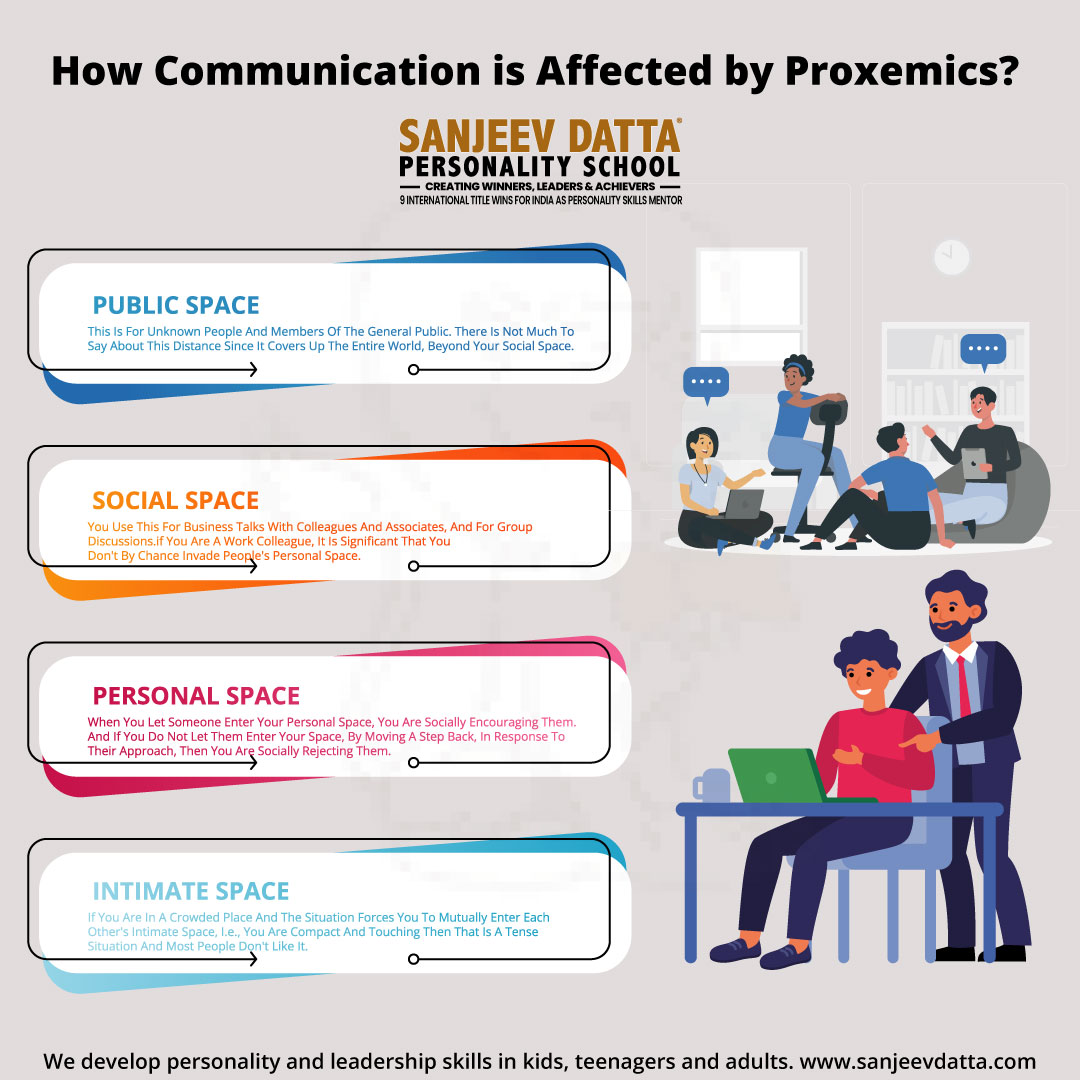Proxemics examines how geographical separation affects interpersonal relationships. The nature of a connection can be inferred from the proximity of conversational partners. People are wired to create specific limits between themselves and others regarding physical space. They attribute this inclination to their level of ease and personal taste. So, it is very relevant for people in the field of communications to understand the importance of proxemics in communication to express themselves better.
Importance of Proxemics in Communication
Factors influencing Proxemics

According to the best soft skills coach, many factors influence whether two people are close or distant friends. They are relaxed and at ease until the safe distance is compromised.
Almost all cultures share a similar understanding of this idea. However, there may be subtle variances in how they interpret physical distance. There are some cultures, particularly in Latin America and the Middle East, where “physical closeness” is seen positively. Talking “close” is perfectly fine. For instance, Arabs commonly express their best wishes with a warm embrace and a peck on the forehead.
It is possible that “closeness” is not valued in countries like Asia, where people often prefer to keep their distance. In many societies, infringing on someone’s personal space signifies aggressiveness or sexual curiosity.
The context in which communication takes place might also influence the meaning behind its words. When setting up chairs for a meeting or conference, the director or CEO’s seat is typically situated slightly apart from the rest of the attendees and slightly closer to the center of the room as a symbol of power and authority.
Visit: characteristics of good communication
Importance of Proxemics

Proxemics is useful in talks since it reveals the speaker’s motivations and attitudes. When communicating, greater or lesser distances might convey distinct meanings. However, the availability of breathing room is not the only factor to consider while deciphering someone’s motivations. It is important to use it in conjunction with verbal and nonverbal signals that seem to point to a deliberate goal.
Humans tend to establish firm limits on who they will allow within their sphere of influence. They decide how much room to provide each category of people based on their identity (as friends, family, intimate partners, acquaintances, strangers, etc.).
How people feel about physical connection with their friends and family may differ from how they feel about their romantic partners. They determine the amount of personal space among themselves and everyone else based on their group. They feel violated and uneasy when this boundary is crossed unanticipated.

Different Types of Proxemics

People have diverse ideas about what constitutes “personal space” based on their unique experiences and tastes. According to research, each person has four distinct “zones of competence” with varying levels of interaction.
- Personal space:
Depending on the person, personal space can be anywhere from 1.5 to 4 feet away from their body. Friends, family, and very close acquaintances are only allowed in this section. In this comfort zone, close friends and family members are welcomed with open arms, and friendly touches of any kind are expected and welcomed. When people feel comfortable with each other, they tend to sit closer together; this is especially true at social gatherings.
2. Public Space:
Public areas are the least intimate compared to other types of spaces. The average length is 12 feet. These zones are common while giving presentations or speeches in front of large audiences for work. When around other people, they keep a distance of 12 feet. Maintaining a distance of 12 feet from people is common practice for celebrities and other public figures for both personal safety and as a display of authority. Public speakers, for instance, often stand a considerable distance from their listeners so they can see and speak to everyone in the room.
3. Social Space
The average person’s “social space” is four to twelve feet in diameter. Neither as far nor as close as the private sphere, this is a happy medium. This is the social sweet spot where people you hardly know and people you work with would often interact.
One is not compelled to engage a stranger merely because they are present in a public place. As they get closer, it will become increasingly difficult to ignore them, necessitating contact.
Visit: non verbal communication skills
4. Intimate Space
When the whole length of the room is one foot and fifteen inches or less, we call it an intimate space. Members of one’s inner circle, whether they be a significant other, close friends, or family, are typically the only ones allowed here. The act of another person pressing up against our personal space can be either comfortable, frightening, or even bothersome, depending on the circumstances. In times of stress, it is common for people to seek solace in the arms of their significant ones.
If you are a professional communicator, you need to understand the concepts of proxemics. In that case, consider contacting the best personality grooming coach to understand the nuances of this concept.
Territoriality

Humans, like animals, have a natural inclination to mark territories outside these areas. They feel pride in the house they have built for themselves. Even on the bus, we have our preferences and like to sit in the same spot every time. The term “territoriality” is used to describe this idea. Primary, secondary, and public can be divided into three categories.
The acquired territory is an area that does not belong to someone but is linked to that person somehow. People feel a sense of ownership over it even though they have no direct say in its management. Such as a forgotten lane in the neighborhood that can be used for one’s purposes.
There is now no unified claimant to the public realm. Yet, despite their brief stays, visitors claim it as their own. For instance, a bag left on a seat would serve as a visual indication that the seat has been claimed.
Visit: top social networking skills
Summing Up
Studying the importance of proxemics in communication helps us understand the factors that can make or break our interaction with the world around us. Communication is one of the most important factors in how people perceive us. And proxemics is an important factor that plays an important role in our overall way of communicating.
Why Sanjeev Datta Personality School?
We focus on:
- INTERVIEW TRAINING
- LEADERSHIP
- PRESENTATION TRAINING
- SOCIAL BOLDNESS
- DRESSING ETIQUETTE
- OFFICE ETIQUETTE
- COMMUNICATION SKILLS
- ENGLISH SPEAKING
- ANGER MANAGEMENT
- TIME MANAGEMENT
- TEAM BUILDING
- PERFORMANCE ENHANCER
- SOFT SKILLS
- GOAL SETTING
- CAREER COUNSELLING
- STUDENT SUBJECT CHOICE COUNSELLING
- LISTENING SKILLS
- VIDEO PRESENTATION
- MEDITATION
and more…
For details, contact us now!


